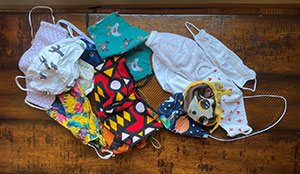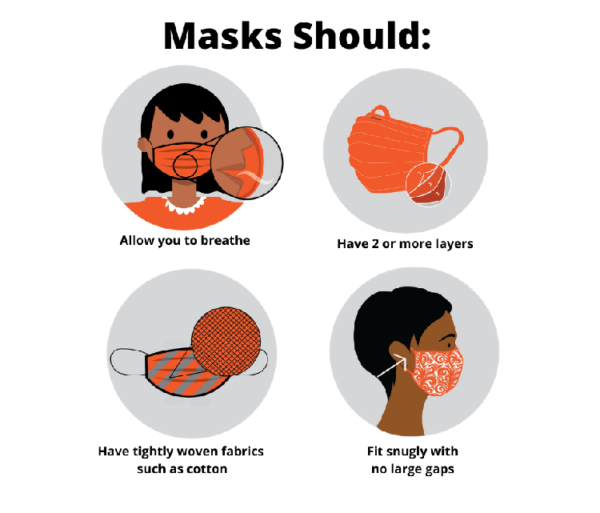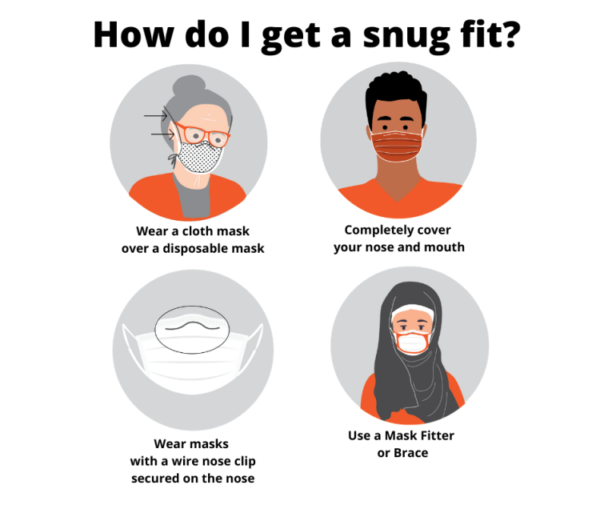Delta, Masking Up is Critical—and It’s Time to Improve the Quality and the Fit

We are now a year and a half into the COVID-19 pandemic. While some things have improved, the pandemic is not over. Case counts are rising again in King County, and Public Health—Seattle & King County currently recommends everyone, regardless of vaccination status, should wear a mask in indoor public spaces and any setting where the risk is higher.
The highly contagious Delta variant requires renewed vigilance—and better “mask hygiene.” We will most likely be dealing with the COVID-19 pandemic longer than we hoped. We must continue to protect our community who are unable to be vaccinated, including kids under 12 and immune-compromised community members.
So, it’s a good time to assess your mask quality and supply—to have the best filtering and best fitting mask or respirator you can. To resist the Delta variant, you’ll want both a good fit and a high-quality mask.

This supply of adult and kid masks needs a refresh to ensure the masks are high enough quality to keep you safe from the Delta variant. Most were purchased or gifted a year and half ago!
Is your mask loose around the cheeks or nose? (Hint: If your glasses fog, your mask is leaking.) Maybe you bought a lot of masks early on and have worn them out? Maybe your kids are growing and the mask no longer fits their faces well? Broken ear loops? Missing nose wires? All good reasons to upgrade.
Here are some tips for masks—and keep in mind, the best protection from COVID-19 for you and your household is getting the COVID-19 vaccination.
Quality mask reminders
Especially in higher risk situations, use the best-quality and best-fitting mask you can get. The highest quality masks are designed and tested to ensure they meet a standard. That means they perform at a consistent level to prevent the spread of COVID-19.
The highest quality, in order, are:
- N95 and KN95 (as well as KF94) are the most effective, provided they are genuine and have been tested to meet a standard. Luckily, the supply of high-quality N95 and KN95 masks has improved. These are better at filtering the virus and now are more widely available for the public. Beware of counterfeits (more on this below). These are disposable, so you will need to replace them (depending on how much you wear it). These are not available in children’s sizes and are more expensive.
- Surgical masks that have been tested to meet a national standard (ASTM 2/3). These are also disposable.
- Cloth masks that have a double layer (more on this below). These can be washed and re-used.
Focus on a snug fit—and making the most of a cloth mask
Here are the most important considerations for the general public when selecting a quality cloth mask:
- Fit and filtration are the keys. Your mask should be:
- 2–3 fabric layers
- Made of tightly woven fabrics such as cotton and cotton blends
- Breathable
- Snug fitting, without gaps around the face
- Wearing a mask with at least two layers is important. You can also wear a disposable mask underneath a cloth mask. (Note: N95/KN95 masks should not be layered with other masks.)
- A snug fit is key for the mask to work well. You can choose masks with a nose wire. Or use a mask fitter to help ensure a snug fit with a cloth mask. Masks that are loose, with gaps around your face or nose, are not as helpful in protecting you or others. For visuals of these tips, visit the guidance for improved mask use from the U.S. Centers for Disease Control and Prevention (CDC).
Find additional mask resources:
- King County posters web page provides multiple mask poster options
- King County mask web page includes guidance on masks and kids
When to consider wearing a mask that meets a standard like an N95 or KN95
 For the best protection against the Delta variant, there are times when we should consider higher quality masks. In certain situations, it’s especially important. The masks that are best at filtering the virus—especially if you can get a snug fit all around your cheeks and nose—are N95 and KN95, along with KF94. However, if you do not have this available, wear an alternative, high-quality well-fitting mask.
For the best protection against the Delta variant, there are times when we should consider higher quality masks. In certain situations, it’s especially important. The masks that are best at filtering the virus—especially if you can get a snug fit all around your cheeks and nose—are N95 and KN95, along with KF94. However, if you do not have this available, wear an alternative, high-quality well-fitting mask.
Scenarios where you may need better protection against COVID-19 can include:
- Being in close or prolonged contact with people whose vaccination status is unknown
- Being in crowded indoor settings or settings with poor ventilation
- Riding on planes, buses, trains, or other forms of public transportation, especially when you can’t keep at least 6 feet away from people who don’t live with you
- Taking care of someone who is sick with COVID-19
- Working at a job where you interact with large numbers of the public
- If you are at increased risk for severe illness, for example, older adults or people with certain underlying medical conditions
But before you run out to find an N95 mask (technically considered a respirator), following are the upsides and downsides of a mask like an N95.
- Because they are best at filtering the virus, the CDC continues to encourage that N95 masks should be prioritized for health care workers. However, they allow for N95 use in non-healthcare settings as the availability increases. As of early August, supply has improved, and many health experts are recommending higher quality masks.
- N95 masks are highly effective when used properly. They are tight-fitting respirators that (when fit properly) filter out at least 95% of particles in the air, including large and small particles.
- These masks meet a standard, meaning they are designed and tested to ensure they perform at a consistent level to prevent the spread of COVID-19. Certain N95 (approved by NIOSH in the United States), KN95 (meets Chinese standard), and KF94 (meets South Korean standard) are examples of masks that have been tested.
Downsides
- Most people outside of health care settings don’t have access to fit testing, to ensure proper use with minimal air leakage. If an N95 does not fit tightly, you won’t get the full benefit.
- Some people find N95s are not comfortable or easy to wear. Use your best judgement on how much value they add in a particular scenario. If you need to wear a mask for many hours at a time, for example, you may prioritize comfort. Wearing an uncomfortable mask is more likely to encourage multiple adjustments or even removing it, which would reduce its value. Try different models to find one that fits your face.
N95 masks are not meant or designed for children.
Counterfeits are a challenge, so find a reputable dealer and make sure the product is legitimate. KN95 masks are commonly made and used in China. Some KN95 masks sold in the United States meet requirements similar to those set by NIOSH, while other KN95 masks do not. It is also important to know that about 60% KN95 masks in the United States are counterfeit (fake) and DO NOT meet NIOSH requirements. Some N95 masks also are counterfeits, described in this article from the CDC.
Project N95 aims to help people find a credible source for buying N95 and KN95. Be sure your N95 or KN95 is the kind without an exhalation valve.
Why is wearing a face covering still important?
Masks protect the wearer and other people from getting COVID-19. When a person talks, coughs, sneezes, or even breathes, they are exposing the people around them to respiratory droplets, and even smaller particles called aerosols. Masks help prevent the particles that contain the virus from spreading. Masks can be helpful in situations where someone has been infected but doesn’t have symptoms of COVID-19, and they may unintentionally spread the virus. Masks also provide some protection to the wearer by filtering droplets and particles out of the air.
The Delta variant spreads twice as easily from one person to another, compared with earlier strains. The latest data shows that although it’s uncommon for vaccinated people to become infected with COVID-19, it can happen, and Delta makes this more likely than previously. Delta also increases the chance that some vaccinated people who do become infected would spread the infection to others, primarily those who are unvaccinated.
Until everyone can be vaccinated, the growing presence of the Delta variant requires us to double down on mask wearing.
 Contributor Erin Murphy is a communications specialist at Public Health—Seattle & King County. Her article was originally published August 10, 2021 on Public Health Insider.
Contributor Erin Murphy is a communications specialist at Public Health—Seattle & King County. Her article was originally published August 10, 2021 on Public Health Insider.
![AgeWise King County [logo]](https://www.agewisekingcounty.org/wp-content/themes/agewisekingcounty/images/logo.png)
